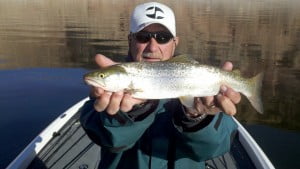Photo caption: Brian Hammond, Page, AZ, caught a brown trout in Padre Bay. The bigger surprise is that more brown trout and a rainbow have been recently caught. Looks like bunch of trout were washed downstream last year with the big flood. It will be a very interesting year to fish at Lake Powell.
Lake Powell Fish Report – March 21, 2012
Lake Elevation: 3635
Water Temperature 50-57 F
By: Wayne Gustaveson
Imagine my surprise when checking the water level to find out that Lake Powell has risen since the last report. Normally lake level does not climb until April. The recent wet storm front has already had an impact on the lake. Now lake level will likely continue the normal slow decline expected in March but that was really fun to see the little bump in elevation.
The big storm also slowed down lake warming. Base temperature did not change remaining at 50 F. There were no shallow coves warming into the 60s this week. But the front has passed and now warm weather is here again. Fish will respond and resume feeding as they have the past few weeks.
Fish haven’t yet moved. Here is a reminder of the general pattern for success. First look for murky green water in the backs of canyons and coves. Cloudy water will be slightly warmer and more productive than clear. Second, most fish are associated with brush thickets with submerged brush hidden 5-10 feet under the surface being the most productive.
Bass anglers fishing in early season tournaments have found bass to be willing and larger than normal. In two tournaments held at Wahweap this past weekend winning weights for 5 bass have exceeded 21 pounds. Largest tournament bass have consistently been heavier than 5 pounds. It looks like a very good year for largemouth bass fishing with many more trophy bass yet to be caught. Largemouth are now found in 15-25 feet of water near brush. As the water warms again they will go much shallower.
Warming water will energize smallmouth bass that prefer water warmer than 57 degrees before they really get active. All bass will move shallower as water warms. They can feel that warmer water in the shallows at the back of a cove and want to swim in warmer water. I can’t blame them a bit. I would seek out warmer water as well.
Stripers are in the brush but usually toward the middle of the cove instead of along the edge. We found last week as water warmed that stripers moved shallower. The shift was subtle with fish moving from 25-foot bottom depth to 18 feet. That causes a few problems as the tree tops are closer to the surface making it necessary to use a shallower running plug. The best striper lures, trolled or cast, last week were those that ran near 4 feet.
The tip for this week is to use small rattletraps that will swim in that narrow zone above tree top levels but depth enough to interest bass and stripers that reside in the trees.
It seems much easier to head to the main channel and put on an anchovy instead of using a micrometer to determine how deep the lure will run. The problem with that strategy is stripers have not left the canyons and are not in the main channel. Fishing success will only come to those that fish where the fish are. I wish you success.




